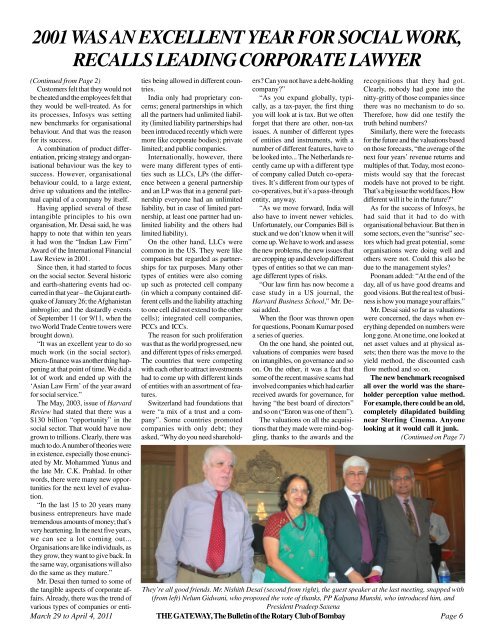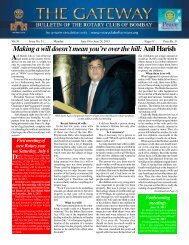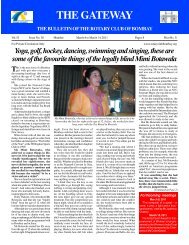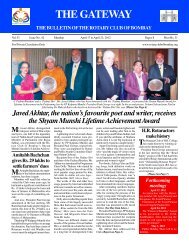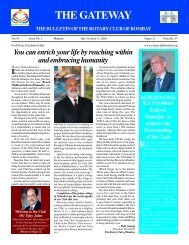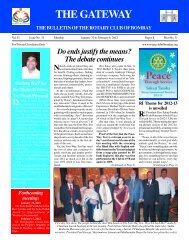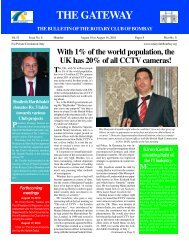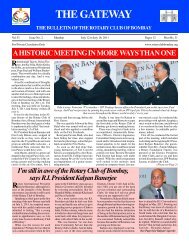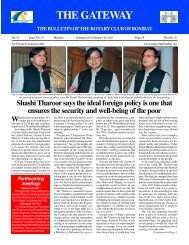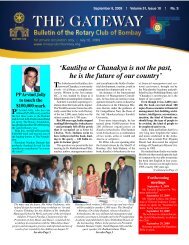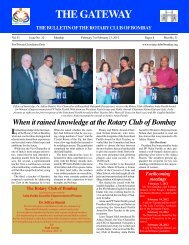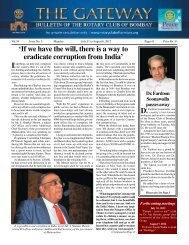2001 WAS AN EXCELLENT YEAR FOR SOCIAL WORK,RECALLS LEADING CORPORATE LAWYER(Continued from Page 2)Customers felt that they would notbe cheated and the employees felt thatthey would be well-treated. As forits processes, Infosys was settingnew benchmarks for organisationalbehaviour. And that was the reasonfor its success.A combination <strong>of</strong> product differentiation,pricing strategy and organisationalbehaviour was the key tosuccess. However, organisationalbehaviour could, to a large extent,drive up valuations and the intellectualcapital <strong>of</strong> a company by itself.Having applied several <strong>of</strong> theseintangible principles to his ownorganisation, Mr. Desai said, he washappy to note that within ten yearsit had won the “Indian Law Firm”Award <strong>of</strong> the International FinancialLaw Review in 2001.Since then, it had started to focuson the social sector. Several historicand earth-shattering events had occurredin that year – the Gujarat earthquake<strong>of</strong> January 26; the Afghanistanimbroglio; and the dastardly events<strong>of</strong> September 11 (or 9/11, when thetwo World Trade Centre towers werebrought down).“It was an excellent year to do somuch work (in the social sector).Micro-finance was another thing happeningat that point <strong>of</strong> time. We did alot <strong>of</strong> work and ended up with the‘Asian Law Firm’ <strong>of</strong> the year awardfor social service.”The May, 2003, issue <strong>of</strong> HarvardReview had stated that there was a$130 billion “opportunity” in thesocial sector. That would have nowgrown to trillions. Clearly, there wasmuch to do. A number <strong>of</strong> theories werein existence, especially those enunciatedby Mr. Mohammed Yunus andthe late Mr. C.K. Prahlad. In otherwords, there were many new opportunitiesfor the next level <strong>of</strong> evaluation.“In the last 15 to 20 years manybusiness entrepreneurs have madetremendous amounts <strong>of</strong> money; that’svery heartening. In the next five years,we can see a lot coming out...Organisations are like individuals, asthey grow, they want to give back. Inthe same way, organisations will alsodo the same as they mature.”Mr. Desai then turned to some <strong>of</strong>ties being allowed in different countries.India only had proprietary concerns;general partnerships in whichall the partners had unlimited liability(limited liability partnerships hadbeen introduced recently which weremore like corporate bodies); privatelimited; and public companies.Internationally, however, therewere many different types <strong>of</strong> entitiessuch as LLCs, LPs (the differencebetween a general partnershipand an LP was that in a general partnershipeveryone had an unlimitedliability, but in case <strong>of</strong> limited partnership,at least one partner had unlimitedliability and the others hadlimited liability).On the other hand, LLCs werecommon in the US. They were likecompanies but regarded as partnershipsfor tax purposes. Many othertypes <strong>of</strong> entities were also comingup such as protected cell company(in which a company contained differentcells and the liability attachingto one cell did not extend to the othercells); integrated cell companies,PCCs and ICCs.The reason for such proliferationwas that as the world progressed, newand different types <strong>of</strong> risks emerged.The countries that were competingwith each other to attract investmentshad to come up with different kinds<strong>of</strong> entities with an assortment <strong>of</strong> features.Switzerland had foundations thatwere “a mix <strong>of</strong> a trust and a company”.Some countries promotedcompanies with only debt; theyasked, “Why do you need shareholders?Can you not have a debt-holdingcompany?”“As you expand globally, typically,as a tax-payer, the first thingyou will look at is tax. But we <strong>of</strong>tenforget that there are other, non-taxissues. A number <strong>of</strong> different types<strong>of</strong> entities and instruments, with anumber <strong>of</strong> different features, have tobe looked into... The Netherlands recentlycame up with a different type<strong>of</strong> company called Dutch co-operatives.It’s different from our types <strong>of</strong>co-operatives, but it’s a pass-throughentity, anyway.“As we move forward, India willalso have to invent newer vehicles.Unfortunately, our Companies Bill isstuck and we don’t know when it willcome up. We have to work and assessthe new problems, the new issues thatare cropping up and develop differenttypes <strong>of</strong> entities so that we can managedifferent types <strong>of</strong> risks.“Our law firm has now become acase study in a US journal, theHarvard Business School,” Mr. Desaiadded.When the floor was thrown openfor questions, Poonam Kumar poseda series <strong>of</strong> queries.On the one hand, she pointed out,valuations <strong>of</strong> companies were basedon intangibles, on governance and soon. On the other, it was a fact thatsome <strong>of</strong> the recent massive scams hadinvolved companies which had earlierreceived awards for governance, forhaving “the best board <strong>of</strong> directors”and so on (“Enron was one <strong>of</strong> them”).The valuations on all the acquisitionsthat they made were mind-boggling,thanks to the awards and therecognitions that they had got.Clearly, nobody had gone into thenitty-gritty <strong>of</strong> those companies sincethere was no mechanism to do so.Therefore, how did one testify thetruth behind numbers?Similarly, there were the forecastsfor the future and the valuations basedon those forecasts, “the average <strong>of</strong> thenext four years’ revenue returns andmultiples <strong>of</strong> that. Today, most economistswould say that the forecastmodels have not proved to be right.That’s a big issue the world faces. Howdifferent will it be in the future?”As for the success <strong>of</strong> Infosys, hehad said that it had to do withorganisational behaviour. But then insome sectors, even the “sunrise” sectorswhich had great potential, someorganisations were doing well andothers were not. Could this also bedue to the management styles?Poonam added: “At the end <strong>of</strong> theday, all <strong>of</strong> us have good dreams andgood visions. But the real test <strong>of</strong> businessis how you manage your affairs.”Mr. Desai said so far as valuationswere concerned, the days when everythingdepended on numbers werelong gone. At one time, one looked atnet asset values and at physical assets;then there was the move to theyield method, the discounted cashflow method and so on.The new benchmark recognisedall over the world was the shareholderperception value method.For example, there could be an old,completely dilapidated buildingnear Sterling Cinema. Anyonelooking at it would call it junk.(Continued on Page 7)the tangible aspects <strong>of</strong> corporate affairs.Already, there was the trend <strong>of</strong>various types <strong>of</strong> companies or enti-They’re all good friends. Mr. Nishith Desai (second from right), the guest speaker at the last meeting, snapped with(from left) Nelum Gidwani, who proposed the vote <strong>of</strong> thanks, PP Kalpana Munshi, who introduced him, andPresident Pradeep SaxenaMarch 29 to April 4, 2011 THE GATEWAY, The Bulletin <strong>of</strong> the <strong>Rotary</strong> <strong>Club</strong> <strong>of</strong> <strong>Bombay</strong> Page 6
The <strong>Rotary</strong> Foundation sets up a disaster fund for JapanIn response to the massive earthquakeand tsunami that struckJapan on March 11, The <strong>Rotary</strong>Foundation has established the<strong>Rotary</strong> Japan 2011 Disaster RecoveryFund which will supportlong-term recovery projects inaffected areas.Rotarians and non-Rotarians candonate online. <strong>Club</strong>s and Districtscan also contribute cash andDistrict Designated Fund (DDF)allocations to this fund.The 9.0-magnitude quake, Japan’slargest in history, and the tsunamithat followed it causedwidespread devastation, paralysingmuch <strong>of</strong> the country’s northerncoast. More than 10,000people have been killed and thousandsare missing. Millions havebeen left without clean water orpower and at least 550,000people have been forced fromtheir homes.A series <strong>of</strong> explosions at the FukushimaDaiichi nuclear power‘2001 was an excellent year to do social work’(Continued from Page 6)But the perception was that if onebought it and made something out <strong>of</strong>it, it would become like a palace.“So I may pay an extraordinaryprice if I perceive that I can createvalue out <strong>of</strong> it, rather than it having aper se value. The shareholder perceptionvalue method is a recognisedmethod for valuing companies.“Most <strong>of</strong>ten, even if you have thebest <strong>of</strong> numbers, people feel that youare a dishonest company and will notbelieve your numbers, because (and Isay this in a lighter vein) many accountantssay, you tell us the numbers,we will put them in the balancesheet. Of course, I’m not generalisingin any way.“But the thing is that you have todo the right things, communicate themin the right way and actually carrythem out in the right way.”PP Anil Chopra, a Visiting Rotarianfrom <strong>Bombay</strong> Down-Town, referredto the speaker’s theory <strong>of</strong> intangiblesand wondered whether corporationswere spending more time trying toalign with business processes andCSR and, in the bargain, neglectingalignment with code <strong>of</strong> integrity standards?Mr. Desai said not only the alignmentreferred to, but everything elseplant, about 200 km. northeast<strong>of</strong> Tokyo, damaged reactors andforced the evacuation <strong>of</strong> tens <strong>of</strong>thousands <strong>of</strong> people. The Japanesegovernment is working tocontain the situation. Damagefrom the earthquake and tsunamiis estimated at US$170 billion.R.I. President-Nominee SakujiTanaka <strong>of</strong> the <strong>Rotary</strong> <strong>Club</strong> <strong>of</strong>Yashio, Saitama, was in Lisbon,Portugal, on <strong>Rotary</strong> businessduring the disasters. He was ableto reach his wife, Kyoko, on thephone to confirm her safety.“She said it was the most horrifyingexperience she had ever had,”says Sakuji. “The northern region<strong>of</strong> Japan is still in chaos. We areunsure when this chaos will endor when things will get better.However, I am most thankful toknow that Rotarians around theworld care for us.”Japanese R.I. Directors MasaomiKondo and Masahiro Kuroda, aswell as staff at <strong>Rotary</strong> International’sJapan <strong>of</strong>fice, are confirmedto be safe.<strong>Rotary</strong> <strong>Club</strong>s and Districts worldwideare mobilising efforts to takeurgently needed aid to the victims.“I’ve received many messages fromRotarians all over the world,”says Noriko Futagami, the PublicImage Resource Group Coordinatorfor Zone 2.“I also have reports that <strong>Rotary</strong><strong>Club</strong>s have begun to start planningprojects for immediate help.Unfortunately, there are manyRotarians and families whohaven’t been able to be contacted.Rotarians in Japan worry fortheir safety.”R.I. President-Nominee SakujiTanaka says he is grateful for thewarm support <strong>of</strong> Rotariansworldwide.“The great thing about Rotarians isthat we share everything, includingeach other’s joy and sadness.depended first and foremost on thecorporate’s philosophy. This had tobe articulated along with the parameters,the objectives and the benchmarksthat it had set up for measuringitself. These had to be based onintangibles that were measurable, too.Processes were important, but thephilosophy behind them could notbe ignored. Therefore, benchmarkshad to be measurable in terms <strong>of</strong> ethics,too. That would be like “going tothe heart”.Mr. Desai said that the most importantissue that everyone wouldhave to confront would be corruption.How would the issue <strong>of</strong> corruptionwithin an organisation bemanaged?Some time back, one <strong>of</strong> the largebusiness groups wanted to set up atrust to make political donations.That was the philosophical interest<strong>of</strong> that company. But it had to makeup its mind whether, if and when itexpanded in, say, Africa, it would givepolitical donations in that country,too?On the other hand, there were companiesthat had decided not to makepolitical contributions even if thesewere legal. This would then be thecompany’s worldwide policy – <strong>of</strong>giving no political donations anywherein the world. IBM’s policy forpublic affairs stated that it would notmake any kind <strong>of</strong> contribution to anypolitical party and would not paybribes or do any such thing. This wasits single, worldwide policy.In case a company allowed itsemployees to campaign for a candidate,they would be allowed to take afew days <strong>of</strong>f but at their own costand risk. As for the days on whichthey worked for a political candidate,those days would be deemed a contributionto a political party – andtherefore they would not be paid asalary for those days.“Do we have the courage to adoptthose kinds <strong>of</strong> policies? It’s a philosophicalchoice. Corruption is goingto create a lot <strong>of</strong> issues. As it is, inIndia we read about corruption everymorning. It becomes a habit withpeople. I have seen people doingthings in India and then going elsewhereand trying the same thingsthere.”It was at this stage that Mr. Desaireferred to the three big problems <strong>of</strong>the day, viz., greed, speed and scaleand his exposition there<strong>of</strong> that hasbeen referred to in detail at the beginning<strong>of</strong> this report.The vote <strong>of</strong> thanks was proposedby Nelum Gidwani.They have the ability to putthemselves in the position <strong>of</strong> othersand act to help,” he says. “Despitethe unthinkable hardshipwe’re experiencing now, thepeople <strong>of</strong> Japan will not give upon efforts to rebuild their communities.”Group StudyExchange (GSE)team is safeRobert Blackburn was leading aGroup Study Exchange (GSE)team in Japan when the earthquakestruck. The five team members fromIllinois, USA, were in a hotel in Tokyo,getting ready for a farewell dinnerwith their hosts.“It was our last night in Japan. Ifelt the whole building shake,” saysRobert, a member <strong>of</strong> the <strong>Rotary</strong><strong>Club</strong> <strong>of</strong> Westmont. “It was not justa mild tremor. My hotel room wasshaking from side to side. It felt likeforever. I have never been so scaredin my life.”He says the earthquake lasted atleast two minutes. He used a laundrycart outside his hotel room forprotection. After the tremorsstopped, he walked 18 floors downto the lobby, where the rest <strong>of</strong> theGSE team congregated.“The airport was temporarilyclosed, so I told everyone on ourteam that we might have to be herefor a day or two longer. Thankfully,the airport reopened. Our hostswere incredible and were able to getus to the airport on time for ourflight,” he adds.One Pr<strong>of</strong>itsMost WhoServes BestServiceAboveSelfMarch 29 to April 4, 2011 THE GATEWAY, The Bulletin <strong>of</strong> the <strong>Rotary</strong> <strong>Club</strong> <strong>of</strong> <strong>Bombay</strong> Page 7


